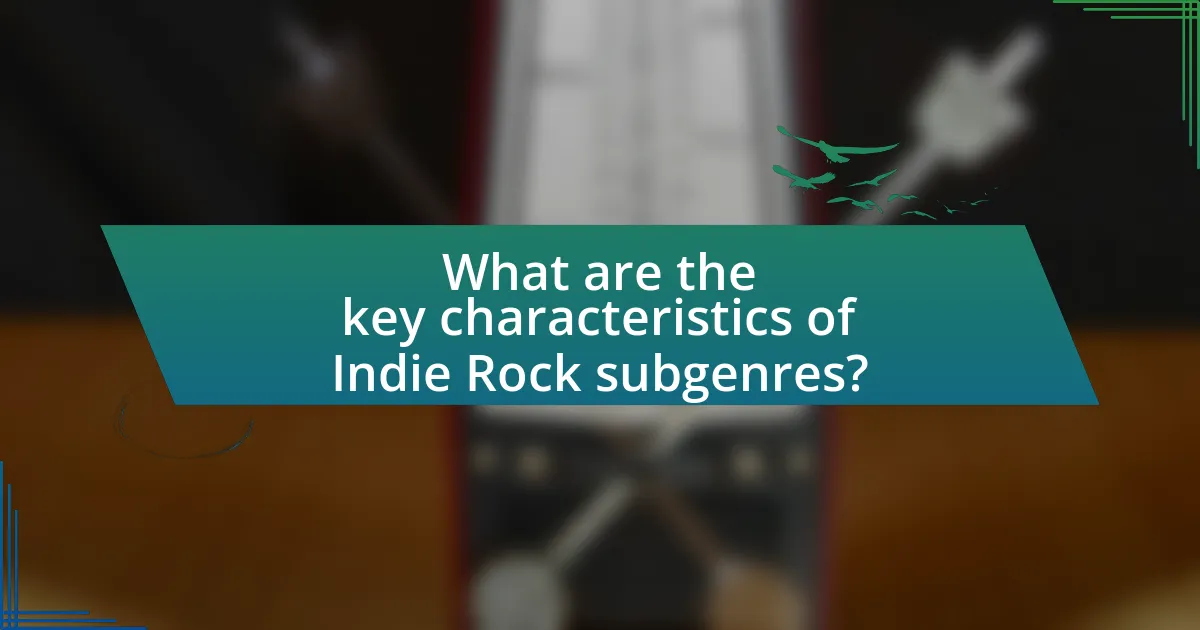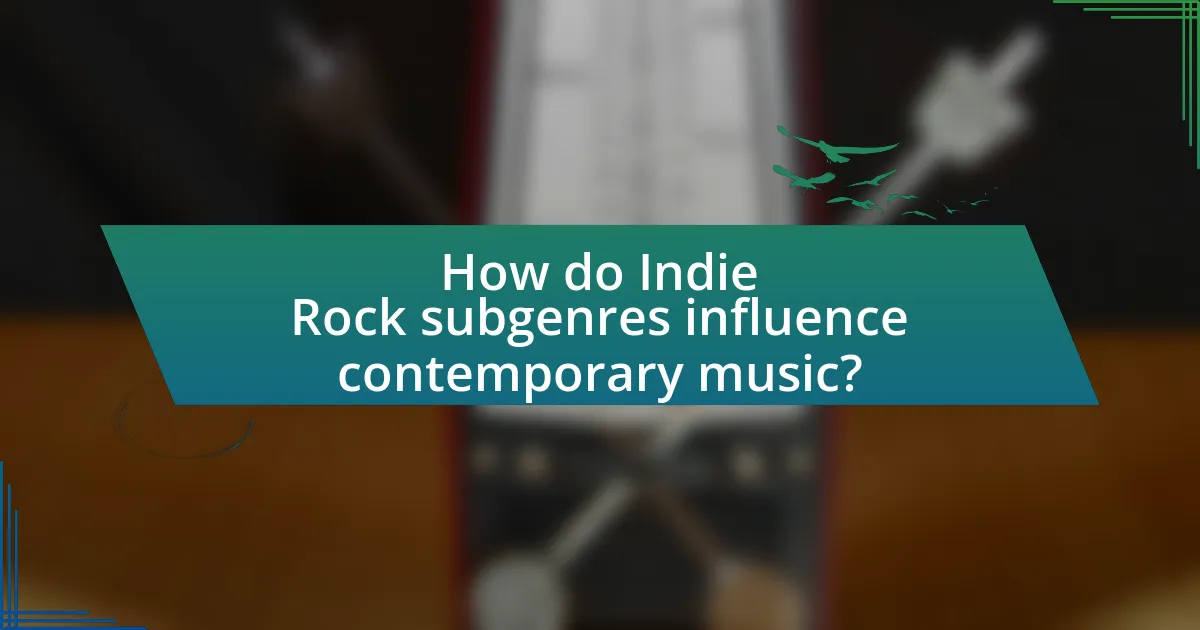The article provides a comparative review of various Indie Rock subgenres, focusing on key characteristics, historical roots, and cultural influences. It examines distinct subgenres such as Lo-Fi, Dream Pop, Post-Rock, and Garage Rock, highlighting their unique soundscapes, production techniques, and lyrical themes. The discussion includes the evolution of these subgenres since the 1980s, the role of independent labels in fostering artistic freedom, and the impact of technology and changing listener preferences on contemporary Indie Rock. Additionally, the article explores emerging trends and offers tips for exploring and appreciating the diversity within the Indie Rock genre.

What are the key characteristics of Indie Rock subgenres?
Indie Rock subgenres are characterized by their diverse soundscapes, DIY ethos, and distinct lyrical themes. Each subgenre, such as Lo-Fi, Dream Pop, and Post-Rock, showcases unique musical elements; for instance, Lo-Fi often features raw production quality and a nostalgic feel, while Dream Pop is known for its ethereal sound and atmospheric textures. The DIY ethos prevalent in Indie Rock emphasizes artistic independence and self-production, allowing artists to explore unconventional sounds and themes. This diversity is supported by the genre’s evolution since the 1980s, where bands like The Smiths and Sonic Youth laid the groundwork for various subgenres, influencing countless artists and shaping the Indie Rock landscape.
How do Lo-Fi and Dream Pop differ in sound and style?
Lo-Fi and Dream Pop differ significantly in sound and style, with Lo-Fi characterized by its raw, unpolished production and Dream Pop defined by its ethereal, atmospheric qualities. Lo-Fi music often incorporates elements like tape hiss, distortion, and a DIY aesthetic, creating a sense of intimacy and authenticity. In contrast, Dream Pop features lush soundscapes, reverb-drenched vocals, and melodic hooks, aiming to evoke a dreamy, otherworldly experience. The distinction is evident in artists such as Daniel Johnston, who exemplifies Lo-Fi’s rough edges, while bands like Cocteau Twins showcase the polished, immersive sound typical of Dream Pop.
What are the defining features of Lo-Fi music?
Lo-Fi music is characterized by its intentionally low fidelity sound quality, which often includes imperfections such as background noise, distortion, and tape hiss. These features create a raw and unpolished aesthetic that contrasts with high-fidelity recordings. Additionally, Lo-Fi music frequently incorporates elements of ambient sounds, samples from various sources, and a relaxed tempo, contributing to its laid-back vibe. The genre emerged prominently in the 1980s and 1990s, with artists like Daniel Johnston and bands such as Guided by Voices exemplifying its defining traits through their DIY recording techniques and emphasis on emotional authenticity.
What elements make Dream Pop unique?
Dream Pop is unique due to its ethereal soundscapes, lush instrumentation, and introspective lyrics. The genre often features reverb-laden guitars, synthesizers, and soft, airy vocals that create a dreamy atmosphere. This sonic quality is exemplified in the works of bands like Cocteau Twins and Beach House, who utilize layered melodies and ambient textures to evoke emotional depth. Additionally, Dream Pop’s focus on mood and atmosphere over traditional song structures distinguishes it from other indie rock subgenres, allowing for a more immersive listening experience.
Why is the evolution of Indie Rock subgenres significant?
The evolution of Indie Rock subgenres is significant because it reflects the genre’s adaptability and cultural relevance over time. This adaptability has allowed Indie Rock to incorporate diverse influences, leading to the emergence of distinct subgenres such as Lo-Fi, Dream Pop, and others. For instance, the rise of Lo-Fi in the 1990s showcased a raw, unpolished sound that resonated with audiences seeking authenticity, while Dream Pop introduced ethereal soundscapes that expanded the emotional range of the genre. This evolution not only illustrates the genre’s dynamic nature but also highlights its ability to engage with changing societal trends and listener preferences, thereby maintaining its prominence in the music industry.
How have cultural influences shaped these subgenres?
Cultural influences have significantly shaped indie rock subgenres by integrating diverse musical styles, themes, and aesthetics. For instance, Lo-Fi subgenre emerged from the DIY ethos of the 1980s punk scene, reflecting a rejection of polished production in favor of raw, authentic sound, which resonated with the underground culture. Similarly, Dream Pop incorporates ethereal soundscapes and introspective lyrics, influenced by the 1980s new wave and shoegaze movements, which were shaped by the cultural context of escapism and emotional exploration prevalent during that era. These subgenres not only reflect the musical trends of their time but also embody the social and cultural narratives that define their origins, such as the rise of counterculture movements and the quest for individual expression.
What role do independent labels play in the development of Indie Rock?
Independent labels are crucial in the development of Indie Rock as they provide a platform for emerging artists to produce and distribute their music outside of mainstream commercial constraints. These labels often prioritize artistic freedom, allowing musicians to explore diverse sounds and styles, which has led to the proliferation of various subgenres within Indie Rock. For example, labels like Sub Pop and Matador Records have been instrumental in launching the careers of influential bands such as Nirvana and Pavement, respectively, showcasing how independent labels can shape the musical landscape by supporting innovative and unconventional artists. This support not only fosters creativity but also cultivates a dedicated fan base that values authenticity over commercial success, further solidifying the identity of Indie Rock as a genre rooted in independence and artistic expression.

What are the most popular Indie Rock subgenres?
The most popular Indie Rock subgenres include Lo-Fi, Dream Pop, Post-Rock, and Garage Rock. Lo-Fi is characterized by its raw sound and DIY aesthetic, often featuring unpolished production techniques. Dream Pop emphasizes atmospheric soundscapes and ethereal vocals, creating a dreamy listening experience. Post-Rock focuses on instrumental compositions and experimental structures, often blending rock with other genres. Garage Rock is known for its energetic and gritty sound, drawing influences from early rock and punk. These subgenres have gained significant traction in the music scene, with numerous artists and bands contributing to their popularity.
Which subgenres fall under the Indie Rock umbrella?
Indie Rock encompasses several subgenres, including Lo-Fi, Dream Pop, Post-Rock, Garage Rock, and Math Rock. Each of these subgenres contributes distinct characteristics to the broader Indie Rock genre. For instance, Lo-Fi is known for its raw sound quality and DIY ethos, while Dream Pop features ethereal soundscapes and melodic vocals. Post-Rock often emphasizes instrumental compositions and atmospheric elements, Garage Rock is characterized by its energetic and unpolished style, and Math Rock incorporates complex time signatures and intricate guitar work. These subgenres collectively illustrate the diversity within the Indie Rock umbrella, showcasing various musical approaches and aesthetics.
What defines the sound of Garage Rock?
Garage Rock is defined by its raw, energetic sound characterized by simple chord progressions, aggressive vocals, and a lo-fi production aesthetic. This genre emerged in the 1960s, often featuring distorted guitars and a fast tempo, which contributed to its rebellious and unpolished feel. Bands like The Sonics and The Stooges exemplified this sound, utilizing minimalistic instrumentation and a DIY ethos that resonated with the youth culture of the time. The genre’s influence can be seen in later movements, such as punk rock, highlighting its foundational role in the evolution of alternative music.
How does Shoegaze contribute to the Indie Rock landscape?
Shoegaze significantly contributes to the Indie Rock landscape by introducing a unique blend of ethereal soundscapes and heavy use of guitar effects, which has influenced numerous bands within the genre. Originating in the late 1980s and early 1990s, shoegaze bands like My Bloody Valentine and Slowdive utilized layers of distorted guitars and reverb, creating a wall of sound that redefined the auditory experience in Indie Rock. This sonic experimentation has inspired contemporary artists, leading to the emergence of subgenres such as dream pop and post-rock, which further expand the boundaries of Indie Rock. The impact of shoegaze is evident in the works of modern bands like Beach House and Tame Impala, who incorporate similar atmospheric elements, demonstrating the lasting legacy of shoegaze within the Indie Rock framework.
What are the historical roots of these subgenres?
The historical roots of indie rock subgenres such as Lo-Fi and Dream Pop can be traced back to the 1980s and 1990s, when alternative music began to diverge from mainstream rock. Lo-Fi emerged as a reaction against polished production, characterized by its raw sound and DIY ethos, influenced by bands like The Velvet Underground and the punk movement. Dream Pop, on the other hand, developed from the ethereal soundscapes of bands like Cocteau Twins and My Bloody Valentine, incorporating lush instrumentation and atmospheric vocals. These subgenres reflect the broader cultural shifts in music, where artists sought authenticity and emotional depth over commercial appeal.
How did the 1980s and 1990s influence modern Indie Rock?
The 1980s and 1990s significantly influenced modern Indie Rock by establishing foundational sounds and DIY ethics that continue to resonate today. The emergence of alternative rock bands like R.E.M. and The Smiths in the 1980s introduced a blend of melodic hooks and introspective lyrics, which shaped the songwriting approach of contemporary Indie artists. Additionally, the 1990s saw the rise of grunge and lo-fi aesthetics, exemplified by bands such as Nirvana and Pavement, promoting a raw, unpolished sound that many modern Indie Rock bands emulate. The proliferation of independent record labels during this period, such as Sub Pop and Matador, fostered a culture of artistic freedom and self-promotion that remains integral to the Indie scene today. These historical developments laid the groundwork for the diverse subgenres within modern Indie Rock, including dream pop and shoegaze, which draw on the sonic experimentation and emotional depth characteristic of the earlier decades.
What impact did the internet have on the rise of Indie Rock subgenres?
The internet significantly accelerated the rise of Indie Rock subgenres by providing platforms for independent artists to share their music widely without traditional gatekeepers. This democratization of music distribution allowed diverse sounds, such as Lo-Fi, Dream Pop, and others, to gain traction and reach global audiences. For instance, platforms like Bandcamp and SoundCloud enabled artists to upload their work directly, fostering niche communities and facilitating the discovery of various subgenres. Additionally, social media played a crucial role in promoting these subgenres, as artists could engage directly with fans and build followings organically. The result was a flourishing of creativity and experimentation within the Indie Rock scene, leading to the emergence of numerous subgenres that might not have found an audience in a pre-internet era.

How do Indie Rock subgenres influence contemporary music?
Indie Rock subgenres significantly influence contemporary music by introducing diverse sounds and innovative production techniques. For instance, the Lo-Fi subgenre emphasizes raw, unpolished recordings, which has led many contemporary artists to embrace a more authentic sound, moving away from overly produced tracks. Additionally, Dream Pop’s ethereal soundscapes have permeated mainstream music, inspiring artists across genres to incorporate lush, atmospheric elements into their work. This cross-pollination is evident in the rise of artists like Billie Eilish, whose music reflects the introspective and experimental qualities found in various Indie Rock subgenres. The impact of these subgenres is further validated by the increasing number of collaborations between Indie artists and mainstream musicians, showcasing the blending of styles and the broader acceptance of Indie influences in popular music.
What trends are emerging within Indie Rock today?
Emerging trends within Indie Rock today include a fusion of genres, increased use of technology in music production, and a focus on social and political themes. Artists are blending elements from electronic, hip-hop, and pop, creating a diverse soundscape that appeals to a broader audience. The rise of home recording technology has enabled musicians to produce high-quality music independently, leading to a surge in DIY releases. Additionally, many Indie Rock bands are addressing contemporary issues such as mental health, climate change, and social justice in their lyrics, reflecting a growing awareness and activism within the genre. These trends indicate a dynamic evolution of Indie Rock, making it more relevant in today’s cultural landscape.
How are artists blending different subgenres in their music?
Artists are blending different subgenres in their music by incorporating elements from various styles to create unique soundscapes. For instance, many indie rock musicians combine the raw, unpolished aesthetics of lo-fi with the ethereal qualities of dream pop, resulting in a sound that is both intimate and expansive. This fusion is evident in tracks that utilize jangly guitars typical of indie pop alongside atmospheric synths characteristic of dream pop, allowing for a rich auditory experience. Additionally, collaborations between artists from different subgenres further facilitate this blending, as seen in projects that merge the rhythmic complexity of math rock with the melodic sensibilities of shoegaze. Such cross-pollination not only broadens the appeal of the music but also reflects the evolving nature of genre boundaries in contemporary music.
What role does technology play in the production of Indie Rock music?
Technology plays a crucial role in the production of Indie Rock music by enabling artists to create, record, and distribute their music with greater accessibility and creativity. Digital audio workstations (DAWs) like Ableton Live and Pro Tools allow musicians to record high-quality tracks at home, reducing the need for expensive studio time. Additionally, advancements in software plugins and virtual instruments provide a wide range of sounds and effects, enhancing the artistic expression of Indie Rock. The rise of online platforms for distribution, such as Bandcamp and SoundCloud, empowers independent artists to reach global audiences without traditional record label constraints. This democratization of music production and distribution has led to a diverse array of sounds within the Indie Rock genre, reflecting the influence of technology on artistic innovation.
What can listeners expect from the future of Indie Rock subgenres?
Listeners can expect a diversification and evolution of Indie Rock subgenres, characterized by the blending of styles and influences from various genres. As artists increasingly experiment with electronic elements, hip-hop rhythms, and global music influences, subgenres like Lo-Fi and Dream Pop are likely to incorporate more diverse soundscapes. This trend is supported by the rise of platforms like Bandcamp and SoundCloud, which allow independent artists to reach wider audiences and collaborate across genres, fostering innovation. Additionally, the growing emphasis on thematic and lyrical depth in Indie Rock suggests that future releases will explore more complex narratives and emotional experiences, reflecting societal changes and personal introspection.
How might changing listener preferences shape the evolution of these subgenres?
Changing listener preferences can significantly shape the evolution of indie rock subgenres by influencing the styles, themes, and production techniques that artists adopt. For instance, as audiences increasingly gravitate towards more polished and accessible sounds, subgenres like Dream Pop may evolve to incorporate mainstream production elements, leading to a broader appeal. Historical trends show that shifts in listener demographics and tastes often prompt artists to adapt; for example, the rise of streaming platforms has led to a resurgence in Lo-Fi aesthetics, as listeners seek authenticity and nostalgia in their music choices. This dynamic interplay between listener preferences and artistic expression drives the continuous transformation of subgenres within the indie rock landscape.
What are some tips for exploring and appreciating Indie Rock subgenres?
To explore and appreciate Indie Rock subgenres, start by listening to a diverse range of artists within each subgenre, such as Lo-Fi, Dream Pop, and Post-Rock, to understand their unique characteristics. Engaging with curated playlists on platforms like Spotify or Apple Music can provide a comprehensive overview of the sound and style of each subgenre. Additionally, attending live shows or local gigs featuring Indie Rock bands allows for a deeper connection to the music and its community. Reading music blogs, reviews, and articles focused on Indie Rock can enhance your understanding of the historical context and evolution of these subgenres. Finally, participating in online forums or social media groups dedicated to Indie Rock can facilitate discussions and recommendations, enriching your appreciation of the genre.




